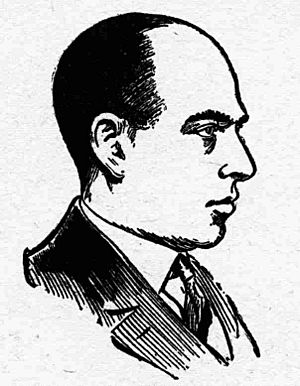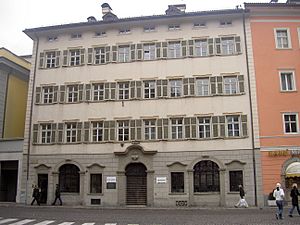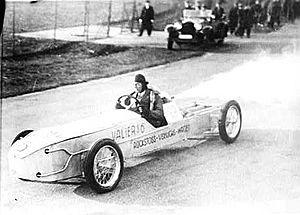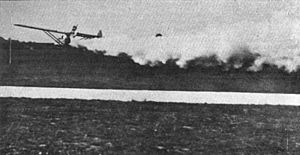Max Valier facts for kids
Quick facts for kids
Max Valier
|
|
|---|---|

Valier as depicted in Air Wonder Stories, February 1930.
|
|
| Born | 9 February 1895 Bolzano, County of Tyrol, Austria-Hungary
|
| Died | 17 May 1930 (aged 35) |
| Nationality | Austrian |
| Alma mater | University of Innsbruck |
| Scientific career | |
| Fields | Physics |
Max Valier (born February 9, 1895 – died May 17, 1930) was an Austrian pioneer in rocket science. He was a key person in the world's first big rocket program, called Opel-RAK. He also helped start the German Verein für Raumschiffahrt (VfR), which means "Spaceflight Society." This group brought together many smart people who later made spaceflight possible in the 20th century.
Contents
About Max Valier
Max Valier was born in Bozen, which is in a region called South Tyrol today. In 1913, he started studying physics at the University of Innsbruck. He also learned how to be a machinist at a factory nearby.
His studies stopped because of World War I. During the war, he worked as an aerial observer in the Austro-Hungarian army's air force.
Becoming a Science Writer
After the war, Valier did not go back to school. Instead, he became a writer who focused on science topics. In 1923, he read a very important book by Hermann Oberth. The book was called Die Rakete zu den Planetenräumen, which means The Rocket into Interplanetary Space.
This book inspired Valier to write his own book. He wanted to explain Oberth's ideas in a way that everyday people could understand. With help from Oberth, Valier published his book, Der Vorstoß in den Weltenraum (The Advance into Space), in 1924.
His book was a huge success. It was printed six times before 1930. After this, he wrote many articles about space travel. Some of his article titles were "Berlin to New York in One Hour" and "A Daring Trip to Mars."
Working with Rocket Cars and Planes
In 1928 and 1929, Max Valier worked with Fritz von Opel. They built several cars and aircraft powered by rockets. This was part of the world's first large rocket program, Opel-RAK.
For von Opel, these experiments were great for his company, Opel. For Valier, they helped more people get interested in rockets. Friedrich Sander supplied the solid-fuel rocket engines for their projects.
Valier and von Opel set new speed records for vehicles on land and rails. Their work also led to the world's first rocket plane. The first public flight of this plane happened on September 30, 1929. Fritz von Opel was the pilot.
After the Opel RAK.1 flight, their partnership ended. This was partly due to the Great Depression. Von Opel left Germany in 1930. Valier then continued to develop rockets on his own.
Developing Liquid-Fuel Rockets
By the late 1920s, the Spaceflight Society (VfR) started focusing on rockets that used liquid fuel. Their first successful test with liquid fuel lasted five minutes. This happened on January 25, 1930.
On April 19, 1930, Valier did the first test drive of a rocket car that used liquid fuel. It was called the Valier-Heylandt Rak 7.
Sadly, Valier died less than a month later. An alcohol-fueled rocket exploded while he was testing it in Berlin. His student, Arthur Rudolph, later created a better and safer version of Valier's engine.
How Max Valier is Remembered
Max Valier is still remembered in South Tyrol as a famous inventor and scientist. Several places and groups are named after him:
- The "Amateurastronomen Max Valier" is an amateur astronomy society in South Tyrol. They have a public observatory called "Max Valier" in Gummer, Italy.
- The "Max Valier" Technological Institute is a school in Bolzano, Italy.
- The Max Valier X-ray telescopic satellite was launched in 2017. It orbits Earth and sends out Morse code signals.
See also
 In Spanish: Max Valier para niños
In Spanish: Max Valier para niños




